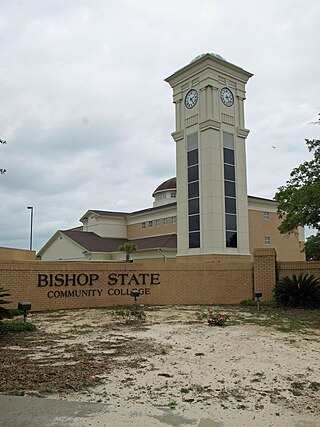Related Research Articles

Goose Creek Consolidated Independent School District (GCCISD) is a school district headquartered in Baytown, Texas, United States.
Brevard Public Schools is a school district serving Brevard County, Florida, and based in Viera, Florida.

The Henegar Center is a historic U.S. building located at 625 East New Haven Avenue, Melbourne, Florida. Built in 1919, it is one of Brevard County’s oldest public buildings. On March 12, 1963, the building received its name in honor of Ruth Henegar, a long-time teacher and principal at the school that used the building at the time. The building now serves as The Henegar Center for the Arts.

Bishop State Community College (BSCC) is a public, historically black community college with campuses and facilities throughout Mobile and Washington Counties in Alabama. The college was founded in Mobile, Alabama, in 1927, and is accredited by the Southern Association of Colleges and Schools Commission on Colleges. It offers more than 50 associate degree and certificate programs.

Leesburg High School is a public high school located in Leesburg, Florida and is one of seven public high schools in Lake County, Florida. The school is made up of approximately 1,500 students. The current principal is Michael Randolph.
Suwannee River Junior College, located in Madison, Florida, opened in 1959. It was one of eleven black junior colleges founded in the late 1950s at the initiative of the Florida Legislature. Since racial integration in schools was prohibited in the Florida Constitution of 1885 then in effect, the Legislature wished to avoid the integration mandated in the unanimous Brown v. Board of Education Supreme Court decision of 1954 by demonstrating that a "separate but equal" higher education system existed in Florida for African Americans.

Eastern Florida State College, formerly Brevard Community College, is a public college in Brevard County, Florida. It is a member of the Florida College System and has campuses in Cocoa, Melbourne, Palm Bay, and Titusville, as well as a Virtual Campus.
Roosevelt Junior College was an institution serving African-American students, located on an 18-acre campus at 1235 Fifteenth Street in West Palm Beach, Florida. It took its name from the adjacent black Roosevelt High School, named in honor of former U.S. President Theodore Roosevelt.
Booker T. Washington Junior College, the first and longest-lasting junior college for African Americans in Florida, was established by the Escambia County school board in 1949. Previously, the only higher education available in Florida to African Americans was at Bethune-Cookman College, Edward Waters College, Florida A&M University, and Florida Memorial College, all historically black.
Gibbs Junior College was created in 1957 by the Pinellas County Board of Public Instruction to serve African-American students in St. Petersburg, Florida. It was the first and most successful of Florida's eleven new African-American junior colleges, founded in an unsuccessful attempt to avoid the racial integration mandated by the unanimous 1954 Supreme Court Brown v. Board of Education decision. It was named for the minister and abolitionist Jonathan C. Gibbs, who opened a private school for freed slaves after the Civil War, and was later Florida's Secretary of State (1868–1872) and then Superintendent of Public Instruction, the first African-American member of the Florida Cabinet.
Jackson Junior College, in Marianna, Florida, county seat of Jackson County, opened its doors in 1961. It was one of eleven black junior colleges founded in the late 1950s at the initiative of the Florida Legislature. Since racial integration in schools was prohibited in the Florida Constitution of 1885 then in effect, the Legislature wished to avoid the integration mandated in the unanimous Brown v. Board of Education Supreme Court decision of 1954 by demonstrating that a "separate but equal" higher education system existed in Florida for African Americans. Support by local African Americans, who wanted integration, was unenthusiastic.
Hampton Junior College, located in Ocala, Florida, opened its doors in 1958. It was one of eleven black community colleges which were founded, at the urging of the Florida Legislature, to show that a "Separate but equal" educational system for blacks existed in Florida; the Legislature wished to avoid the integration mandated by the Supreme Court's Brown v. Board of Education decision of 1954. At the time, the closest public college that would accept negroes was Florida A&M University, 175 miles away.
Rosenwald Junior College, located in Panama City, Florida, opened its doors in 1958. It was one of eleven black junior colleges founded in the late 1950s at the initiative of the Florida Legislature. Since racial integration in schools was prohibited by the Florida Constitution of 1885 then in effect, the Legislature wished to avoid the integration mandated in the unanimous Brown v. Board of Education Supreme Court decision of 1954 by demonstrating that a "separate but equal" higher education system existed in Florida for African Americans.
Volusia County Community College, located at 875 Second Avenue in Daytona Beach, Florida, opened its doors in 1958. It was one of twelve black junior colleges founded in the late 1950s at the initiative of the Florida Legislature. Since racial integration in schools was prohibited in the Florida Constitution of 1885 then in effect, the Legislature wished to avoid the integration mandated in the unanimous Brown v. Board of Education Supreme Court decision of 1954 by demonstrating that a "separate but equal" higher education system existed in Florida for African Americans.
Collier-Blocker Junior College, located at 1100 N. 19th Street in Palatka, Florida, opened its doors in 1960. It was one of eleven black junior colleges founded in the late 1950s at the initiative of the Florida Legislature. Since racial integration in schools was prohibited in the Florida Constitution of 1885 then in effect, the Legislature wished to avoid the integration mandated in the unanimous Brown v. Board of Education Supreme Court decision of 1954 by demonstrating that a "separate but equal" higher education system existed in Florida for African Americans.
Lincoln Junior College, located in Fort Pierce, Florida, opened its doors in 1960, at the same time as Indian River Junior College, restricted to white students. It was designed to serve Indian River, Martin, Okeechobee, and St. Lucie counties. It was one of eleven black community colleges which were founded, at the urging of the Florida Legislature, in the late 1950s and early 1960s to show that a "separate but equal" educational system for blacks existed in Florida; the Legislature wished to avoid the integration mandated by the Supreme Court's Brown v. Board of Education decision of 1954. At the time, there was no nearby college for Negroes, while the distances and lack of funding effectively closed off most local blacks from college.
Johnson Junior College, located at 1200 N. Beecher St. in Leesburg, Florida, opened its doors in 1962 for black students at the same time as Lake-Sumter Junior College for white students. It was designed to serve Lake and Sumter Counties. It was one of eleven black community colleges which were founded, at the urging of the Florida Legislature, in the late 1950s and early 1960s to show that a "separate but equal" educational system for blacks existed in Florida; the Legislature wished to avoid the integration mandated by the Supreme Court's Brown v. Board of Education decision of 1954. At the time, there was no nearby college for Negroes, and the distances and lack of funding effectively closed off most local Blacks from college.
Carver Heights High School was a segregated public school for black students in Leesburg, Florida. It briefly served as the site of segregated Johnson Junior College as well. It was closed when the schools were integrated.

Cocoa Junior High School is a historic school building in Cocoa, Florida. Built in 1923-24, it is one of the oldest remaining Rosenwald Schools in Florida. After the school closed in 1954, the building served as a community center and later as an African-American history museum.
Carver College was a junior college that served African American students in Charlotte, North Carolina. The college operated as the black counterpart to Charlotte College from 1949 to 1963. After merging with the Central Industrial Education Center, the school became Central Piedmont Community College.
References
- ↑ Walter L. Smith, The Magnificent Twelve: Florida's Black Junior Colleges, Winter Park, Florida, FOUR-G Publishers, 1994, ISBN 1885066015, p. 173.
- ↑ Smith, p. 181.
- ↑ Kevin M. McCarthy, African American Sites in Florida, Pineapple Press, 2007, ISBN 1561643858, p. 19.
- ↑ McCarthy, p. 19.
- ↑ Smith, pp. 181-182.
- ↑ McCarthy, p. 19.